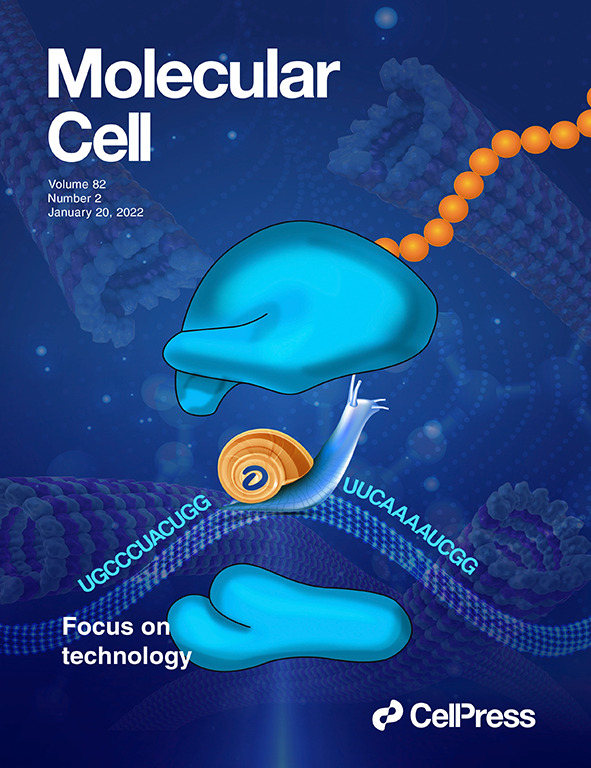果蝇 TrpA1 转录本中替代外显子组装的联系。
IF 3.7
3区 生物学
Q2 BIOCHEMISTRY & MOLECULAR BIOLOGY
引用次数: 0
摘要
果蝇的 TrpA1(瞬时受体电位锑蛋白 1)转录本在两个不同的位点进行交替剪接,每个位点都有一个相互排斥的外显子。第一个位点决定了编码氨基末端的外显子 1,从而产生亲核、嗜电和有害的温度门控 TRPA1(A)或嗜电和无害的温度门控 TRPA1(B)。第二个位点选择外显子 10,从而产生具有外显子 10a 或外显子 10b 的 TrpA1 变体,外显子 10a 或外显子 10b 编码 N 端 ankyrin 重复序列和跨膜片段之间的结构域。尽管无偏组装会产生具有四种不同结构域组合的 TRPA1,但这些替代结构域的功能影响仍有待深入研究。在这里,我们发现在 TrpA1(B)而非 TrpA1(A)转录本中,两个位点之间的 mRNA 剪接存在相对较强的联系。我们的半定量分析包括反转录聚合酶链反应(RT-PCR)和桑格测序,结果显示外显子 10b 与 TrpA1(B)转录本的耦合很少、这表明用我们的方法只能检测到三种同工形式,即 TRPA1(A)-外显子 10a [记作 TRPA1(A)]、TRPA1(A)-外显子 10b [TRPA1(A)10b] 和 TRPA1(B)-外显子 10a [TRPA1(B)]。有趣的是,与其他同工酶相比,异源表达的 TRPA1(A)10b 对低浓度 N-甲基马来酰亚胺(NMM)(一种半胱氨酸修饰亲电子体)的敏感性更高。传播疟疾的冈比亚按蚊中的等效异构体也显示出类似的异构体依赖性 NMM 剂量依赖性模式,这表明昆虫 TRPA1s 中通过选择性结构域组装进行化学感觉调节的做法是保守的。因此,外显子 10 的替代 RNA 剪接与第一外显子协调,调节了昆虫 TRPA1s 的化学敏感性。本文章由计算机程序翻译,如有差异,请以英文原文为准。
Linkage of alternative exon assembly in Drosophila TrpA1 transcripts
Drosophila TrpA1 (transient receptor potential ankyrin 1) transcripts are alternatively spliced at 2 distinct sites each with a choice of mutually exclusive exons. The first site determines exon1 encoding the amino terminus to produce either nucleophile-, electrophile- and noxious temperature-gated TRPA1(A) or electrophile- and innocuous warmth-gated TRPA1(B). The second site selects for exon10, resulting in TrpA1 variants with either exon10a or exon10b encoding a domain between the N-terminal ankyrin repeats and the transmembrane segments. Although unbiased assembly would generate TRPA1 with 4 different domain combinations, the functional impact of these alternative domains remains to be thoroughly examined. Here, we find that there is a relatively strong linkage in mRNA splicing between the 2 sites in the case of TrpA1(B), but not TrpA1(A), transcripts. Our semiquantitative assay, consisting of reverse transcription polymerase chain reaction and Sanger sequencing, revealed that exon10b is little coupled with TrpA1(B) transcripts, suggesting that only 3 isoforms, TRPA1(A)-exon10a [denoted as TRPA1(A)], TRPA1(A)-exon10b [TRPA1(A)10b], and TRPA1(B)-exon10a [TRPA1(B)], are present at detectable levels using our method. Interestingly, heterologously expressed TRPA1(A)10b showed elevated sensitivity to low concentrations of N-methyl maleimide, a cysteine-modifying electrophile, compared with other isoforms. Equivalent isoforms in malaria-transmitting Anopheles gambiae displayed a similar pattern of isoform-dependent N-methyl maleimide dose dependences, suggesting that the chemosensory regulation by selective domain assembly is conserved in insect TRPA1s. Thus, alternative RNA splicing of exon10 is coordinated in conjunction with the first exons, regulating chemical sensitivity of insect TRPA1s.
求助全文
通过发布文献求助,成功后即可免费获取论文全文。
去求助
来源期刊

Molecules and Cells
生物-生化与分子生物学
CiteScore
6.60
自引率
10.50%
发文量
83
审稿时长
2.3 months
期刊介绍:
Molecules and Cells is an international on-line open-access journal devoted to the advancement and dissemination of fundamental knowledge in molecular and cellular biology. It was launched in 1990 and ISO abbreviation is "Mol. Cells". Reports on a broad range of topics of general interest to molecular and cell biologists are published. It is published on the last day of each month by the Korean Society for Molecular and Cellular Biology.
 求助内容:
求助内容: 应助结果提醒方式:
应助结果提醒方式:


